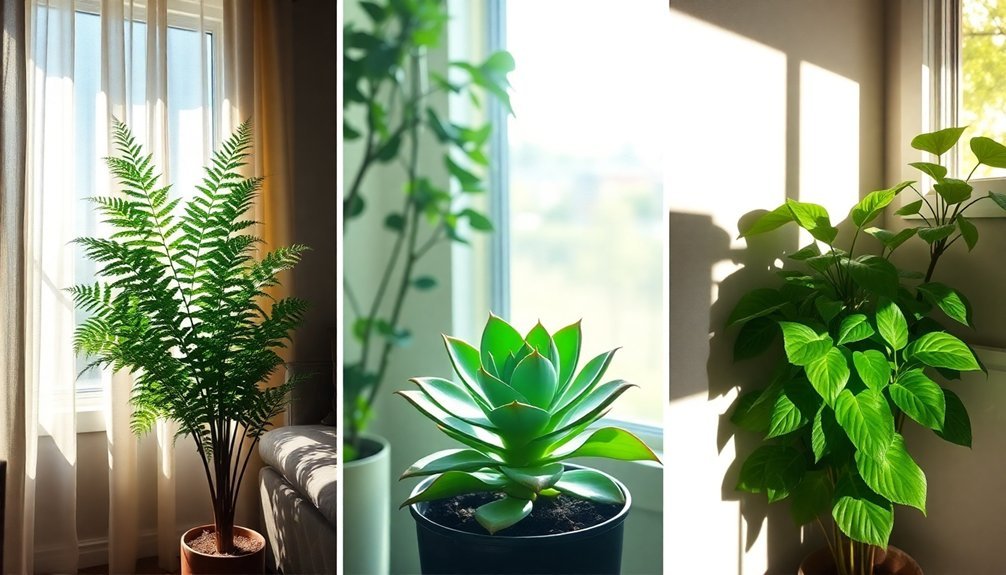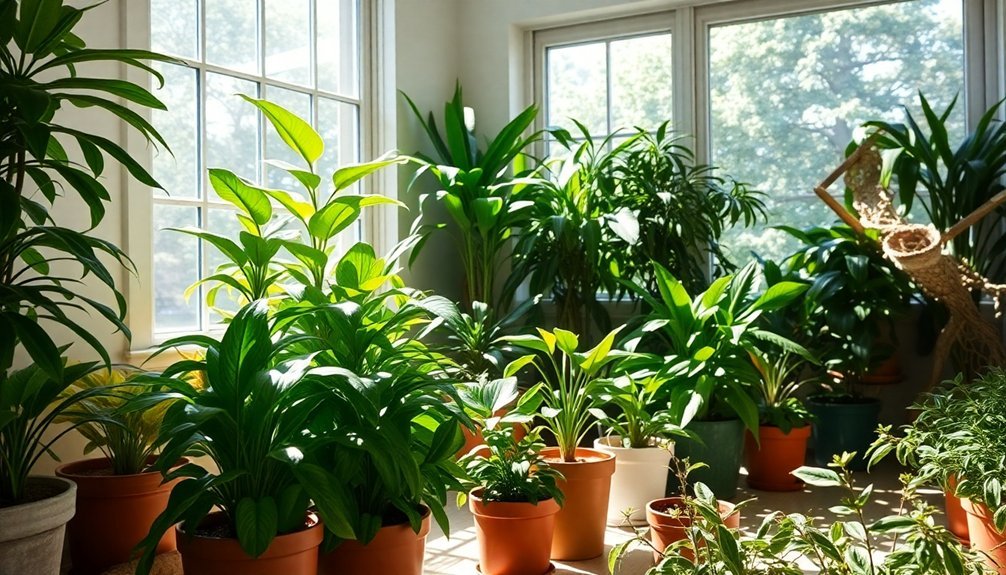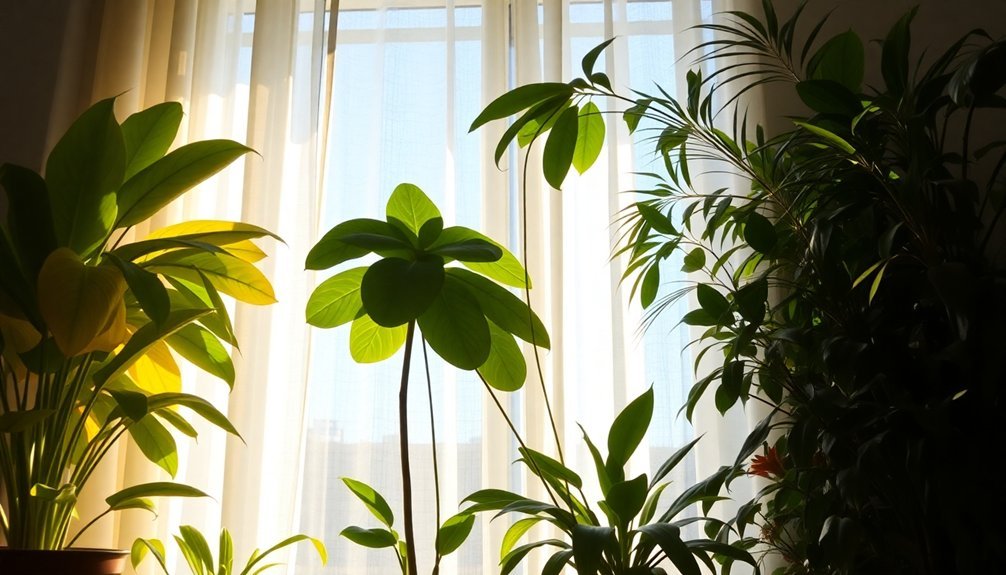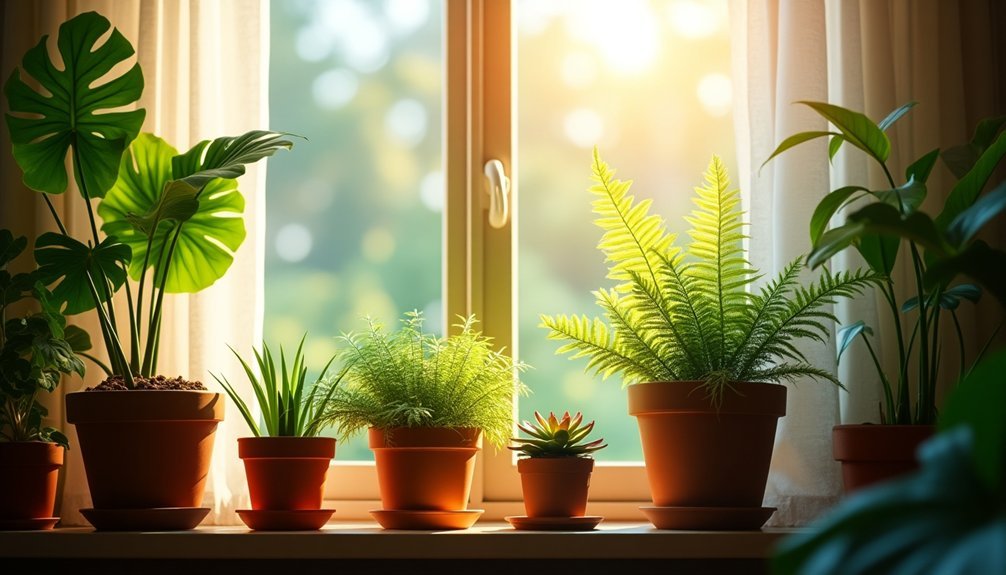Your indoor plants need different light settings because they've evolved in unique natural habitats – from shady forest floors to bright, sunny environments. Each species has adapted specific features like leaf thickness, size, and color to match their native light conditions. You'll need to match these requirements indoors to help them thrive, whether using natural or artificial light. Understanding your plants' light needs will reveal the secret to keeping them healthy and vibrant.
Natural Habitat Light Adaptations

While indoor plants may look similar at first glance, their light requirements stem directly from their natural habitats.
You'll find that understory plants, like ferns, have evolved as low-light plants with broad leaves to capture sparse rays beneath forest canopies. In contrast, high-light plants such as succulents have developed thick, waxy leaves to handle intense natural light.
Your medium-light plants, often tropical varieties, have adapted to thrive in dappled sunlight conditions, making them perfect for moderately lit indoor spaces.
When you're considering flowering plants like the Poinsettia, you'll need to pay special attention to light levels and duration, as these factors trigger their blooming cycles.
Understanding these adaptations helps you match your indoor plants with the right light settings, ensuring they'll flourish in your home environment.
Understanding Light Intensity Measurements
You'll find that understanding light measurements involves three key metrics: lux (which measures visible light), PAR (which specifically tracks light used in photosynthesis), and Kelvin (which indicates light color temperature).
While lux and lumens tell you about brightness levels your plants receive, PAR readings give you the most accurate picture of usable light for plant growth.
Your indoor plants will respond differently to various light colors on the Kelvin scale, with cooler temperatures (5000-6500K) typically promoting vegetative growth and warmer ones (2700-3000K) supporting flowering.
Lux Versus PAR Measurements
Light measurement can be confusing when you're trying to provide the best environment for your indoor plants. While you might be familiar with lux as a measure of light intensity, it's not the most reliable indicator for plant growth.
Instead, you'll want to focus on PAR, which specifically measures the light wavelengths plants use for photosynthesis.
You'll find that different light settings work better for various indoor plants because they've unique light requirements. Even if your space has high lux readings, your plants mightn't be getting the light quality they need.
PAR measurements between 400-700 nanometers give you a more accurate picture of the light your plants can actually use. By understanding both lux and PAR, you can better adjust your lighting to support healthy plant growth.
Kelvin Color Temperature Scale
Beyond PAR and lux measurements, understanding the Kelvin color temperature scale gives you another valuable tool for enhancing your indoor plant lighting. You'll find that different light spectrum ranges support various growth stages. Higher Kelvin values around 6500K produce cooler, blue-tinted light that's perfect for vegetative growth and photosynthesis, while lower values below 3000K create warmer tones ideal for flowering stages.
| Growth Stage | Ideal Kelvin | Light Conditions |
|---|---|---|
| Seedling | 6500K | Cool Daylight |
| Vegetative | 5000-6500K | Bright Blue |
| Flowering | 3000-4000K | Warm White |
| Fruiting | 2700-3000K | Soft Yellow |
When selecting full spectrum indoor light fixtures, you'll want to match the Kelvin color temperature to your plants' current growth phase for best growth results.
Lumens For Plant Growth
Understanding lumens can initially seem straightforward since they measure visible light output, but their relationship to plant growth is more complex than simple brightness levels.
When you're selecting grow lights for your indoor plants, you'll need to look beyond just lumens. While high-light plants might require 2,000 to 3,000 lumens per square meter, low-light plants can thrive with just 100 to 300 lumens.
However, what's more vital is measuring light intensity through PPF and PPFD, as these metrics specifically track the light wavelengths plants use for photosynthesis (400-700 nm range).
These measurements give you a more accurate picture of how much usable light your plants are receiving. To guarantee peak growth, you'll want to match your plant's specific light needs with the appropriate intensity and wavelengths, rather than focusing solely on lumen output.
Growth Patterns and Light Requirements
Your indoor plants' natural growth patterns directly depend on the quality and quantity of light they receive, with each species exhibiting unique adaptations to their light environment.
You'll notice how light drives essential developmental processes, from seedling emergence to mature growth, as your plants respond to different light intensities and durations throughout their life cycles.
If you're growing plants indoors year-round, you'll need to adjust your light settings to match seasonal patterns, ensuring your plants maintain healthy growth even when natural daylight hours decrease.
Natural Growth Vs Adaptation
When bringing plants indoors, you'll discover that each species responds differently to artificial environments based on its natural habitat preferences.
Understanding how your indoor plants adapt to various light settings is essential for their growth and survival. While some plants require bright, direct sunlight, others thrive in low-light conditions that match their native environments.
Here's what you need to know about plant adaptation and light exposure:
- Low-light plants like Snake Plants naturally grow in shaded areas, requiring minimal light quality and exposure time.
- High-light plants such as succulents need intense sunlight settings to maintain their compact growth patterns.
- Most indoor plants can adapt to artificial light sources, but you'll need to match the duration and intensity to their natural requirements.
Light Drives Plant Development
Light acts as the primary engine behind indoor plant development, directly influencing how your plants grow, flower, and maintain their overall health.
Understanding how plants need different light settings is vital for their success, as light intensity and light duration work together to drive photosynthesis and growth patterns.
Your plants respond to specific wavelengths differently – blue light promotes leaf development, while red light triggers flowering.
The Photosynthetic Photon Flux Density determines how much usable light your plants receive, making full spectrum lights an excellent choice for thorough growth.
When you provide insufficient light, you'll notice your plants becoming leggy and pale as they stretch toward light sources.
That's why matching each plant's unique light requirements is essential – some thrive in bright conditions for 6+ hours daily, while others prefer less intense exposure.
Seasonal Light Pattern Impact
Seasonal changes bring distinct challenges for indoor plant care, particularly when it comes to managing light exposure.
Your indoor plants require different light hours throughout the year, as the quality of light and day length naturally fluctuate. During fall and winter's shorter days, you'll need to supplement light to maintain healthy growth, while spring and summer's longer daylight hours typically provide abundant natural light.
Here's what you need to monitor throughout the seasons:
- Light intensity variations, which affect your plants' growth rate and leaf development.
- Photoperiod requirements, especially for flowering plants that bloom based on specific day length patterns.
- Signs of light stress, such as stretched stems or yellowing leaves, indicating when you should adjust light exposure.
Understanding these seasonal changes helps you provide ideal growing conditions for your indoor plants year-round.
Signs of Improper Light Exposure
Identifying signs of improper light exposure can help you catch and correct plant health issues before they become severe.
You'll notice your plants stretching with elongated stems and sparse leaf spacing when they're not getting adequate light. The leaves may also appear pale or whitish due to reduced chlorophyll production, indicating poor health.
On the flip side, if your plants are getting too much light intensity, you'll spot scorched leaves with brown tips and unusual discoloration.
Watch for unexpected leaf drop, especially in older foliage, as it's a common response to excessive light. Your plants might also struggle to bloom or produce fruit when light settings aren't appropriate.
These symptoms signal that you need to adjust your plant's position or modify the light conditions they receive.
Seasonal Light Variations and Plant Response

Throughout the year, indoor plants experience considerable changes in their light exposure as natural daylight fluctuates with the seasons. These seasonal changes greatly impact plant growth, often triggering a dormant phase during winter months when light intensity decreases.
You'll need to adjust your plants' light settings to accommodate these natural variations and maintain ideal light conditions.
To help your plants thrive through seasonal changes:
- Monitor the photoperiod and adjust exposure times – longer in summer, shorter in winter
- Relocate plants based on window orientation – south-facing windows provide consistent light year-round
- Modify artificial lighting to complement natural light fluctuations, especially during shorter winter days
Understanding your plants' responses to seasonal light variations helps you maintain healthy growth patterns and prevent stress from improper light exposure.
You'll notice some plants may even require specific light conditions to trigger flowering or growth cycles.
Artificial Light Solutions and Placement
When natural light falls short, artificial lighting provides a reliable solution for indoor plant growth. You'll find that different light settings considerably impact your plants' health, making proper light placement essential for success.
To achieve ideal light intensity, position your LED grow lights 6 inches above plants, while fluorescent lights need 12 inches and incandescent lights require 24 inches of clearance.
Different grow lights require specific spacing: LEDs at 6 inches, fluorescents at 12 inches, and incandescent bulbs at 24 inches above plants.
You'll want to guarantee your plants receive 12-16 hours of light per day, using a timer to maintain consistent light duration. For the healthiest plant growth, choose full spectrum lighting that mimics natural sunlight, providing all necessary wavelengths for photosynthesis.
Remember that each type of artificial lighting has unique characteristics, from energy efficiency to heat output, so select the option that best matches your plants' specific needs.
Light Duration and Plant Development

Light duration plays a fundamental role in your indoor plants' growth cycle, directly influencing their development from seedling to maturity. Most plants need 12-18 hours of light daily, but timing isn't one-size-fits-all.
You'll need to adjust the amount of light based on your plant's specific requirements, as insufficient light can lead to weak growth and poor flowering.
- Short-day plants like Poinsettias require less than 11 hours of light to bloom
- Long-day plants need more than 14 hours of light for ideal flowering
- Dark periods are essential for crucial physiological processes and nutrient uptake
To maintain consistent light durations, consider using grow lights with timers. This helps guarantee your plants receive the right amount of exposure to their light source, preventing leggy growth and supporting healthy development throughout their lifecycle.
Frequently Asked Questions
Why Do Plants Need Different Amounts of Light?
You'll find that plants need different light amounts because they've evolved in various natural habitats. Some adapted to sunny environments, while others developed under forest canopies, affecting their light requirements for photosynthesis.
What Light Setting Is Best for Indoor Plants?
You'll need to match your plant's natural habitat: south-facing windows for high-light plants, east or filtered west windows for medium-light plants, and north-facing windows or darker spots for low-light varieties.
Are Regular Lights Ok for Plants?
Regular lights aren't ideal for your plants as they lack the full spectrum needed for proper growth. You'll get better results using grow lights that provide the specific wavelengths plants need for photosynthesis.
Can I Use Any Light for Indoor Plants?
You can't use just any light for indoor plants. You'll need specific grow lights, like LEDs or fluorescents, that provide the right spectrum and intensity for photosynthesis, unlike standard household bulbs.
In Summary
You'll find that matching your indoor plants with the right light conditions is essential for their survival and growth. By understanding your plants' natural light preferences and adapting your space accordingly, you're giving them the best chance to thrive. Whether you're using natural or artificial light, remember that proper light exposure directly affects photosynthesis, growth patterns, and overall plant health.





Leave a Reply